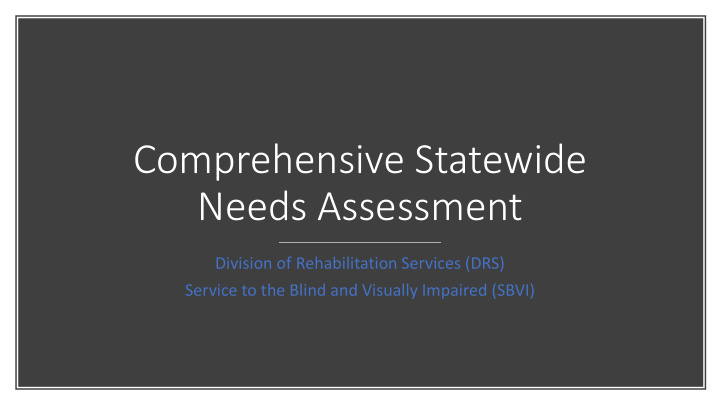



Comprehensive Statewide Needs Assessment Division of Rehabilitation Services (DRS) Service to the Blind and Visually Impaired (SBVI)
A Review and assessment of the Agency’s service history with an emphases on the past three program years. Program Years of 2017, 2018, 2019 What is the Comprehensive An assessment of what is projected to be needed to serve in the next three program years. Statewide Needs Program Years of 2020, 2021 and 2022 Assessment (CSNA) The basis for refreshing the Statewide Program Goals and strategies of Service for the next three program years. 2
Defining and Establishing CSNA Goals Step 1 •Forming the Executive Committee •Addressing preprinted goals of Federal Rules and the states enhancements Step 2 Developing CSNA Plan for Information and Dissemination How is the CSNA Step 3 Gathering the information planned and Designed Step 4 Analyzing the Results and Developing Findings Step 5 Develop the Conclusions: Potential Action Strategies Step 6 informing State Plan, Goals, Priorities, and Strategies 3
• The Federal partner requires for identifying needs and strategy: • Persons with disabilities • Persons with most significant disabilities • Minority groups • Unserved or Underserved Step 2. CSNA • Individual’s served through other components of the work force system Plan & the • Youth and students served through pre-employment, other transitions or Federal Format IDEA coordinated programs • Need to establish or develop Community Rehabilitation Programs (CRP) services (CRPs are Community Support Providers, Mental Health Centers and other similar agencies providing employment related services) 4
What unique characteristics of the Step 2. CSNA Plan state of South Dakota need to be & South Dakota’s addressed in the design of the Comprehensive Statewide Needs unique needs. Assessment for DRS and SBVI. 5
• Field Needs Assessment (Counselors, CRPs, Transitions and Pre-employment) • Needs Literature Review • Informed Leaders Interviews: Work Force Education Step 3 3. Assistive technology Mental Health Services Gatheri ring t the DRS infor ormation SBVI Tribal VR Programs voice o e of need ed • Data Review: annual reports and trends. • DRS and SBVI Board meeting minutes • Listening Sessions (?) 6
The Workforce Innovation and Opportunity Act • the Governor of each State must submit a Unified or Combined State Plan to the Secretary of the U.S. Department of Labor that outlines a four-year strategy for the State’s workforce development system. • Our work in this CSNA feeds into the 2020 South Dakota Workforce Unified Plan. • the Unified Plan initiates July 1 2020. • This CSNA needs to be ready to provide the revised strategies to the DRS/SBVI Central Offices by the end of September 2019. 7
Executive CSNA Committee • The Executive Committee • Advises on the CSNA scope and goals • Membership: • Eric Weiss • Gaye Mattke • DRS Board Chair • SBVI Board Chair • Bernie Grimme • Ronda Williams 8
The DRS Goals and strategy Steps 4-6 Goal 1: Students will enter their adult lives capable of self–advocacy with sufficient The Responsive experience to make choices about work and career, being appropriately supported and living as independently as possible. Plans: DRS Goal 2: A strong statewide community with DRS presence and partnerships with business, service providers, schools, State Government, workforce system and service The Voice of People organizations. with Disabilities Goal 3: DRS clients will have greater access to transportation services needed to obtain inform the Trends and maintain employment. (Narrative and Goal 4: A VR Services delivery system that results in enhanced earnings, employee Numbers) benefits, retention and career advancement for individuals with the most significant disabilities. Goal 5: DRS clients will have the skills, motivation and supports necessary to make an informed choice for successful daily living, employment, money management, personal and work relationships. Not getting lost in the big river 9
Steps 4-6 Goal 1: Develop outreach methods so that referral sources, businesses and Develop citizens who are blind or visually impaired are aware of the unique services provided by SBVI. The Responsive Plans: SBV BVI Goal 2: Improve earnings, benefits, and career advancement for citizens with Improve vision loss. The Voice of People with Disabilities inform the Trends Goal 3: Ensure those who participate in Vocational Rehabilitation have access (Narrative and Numbers) Ensure to an array of services through the workforce system that support career pathways and result in optimal employment outcomes. Goal 4: Strengthen the agency’s ability to provide quality services to citizens Strengthen with vision loss who have barriers to employment. Goal 5: Provide quality transition services to youth with vision loss that Provide facilitate movement from school to post–secondary education and/or successful employment 10
• September 2019 • DRS and SBVI in consultation with Boards: Develop the Conclusions: Potential Action Strategies (Step 5) • Informing State Plan, Goals, Priorities, and Strategies. (Step 6) • Public Hearings (?) • Submit to Secretaries (the bigger river) Step 6: Into the Unified Plan 11
Recommend
More recommend